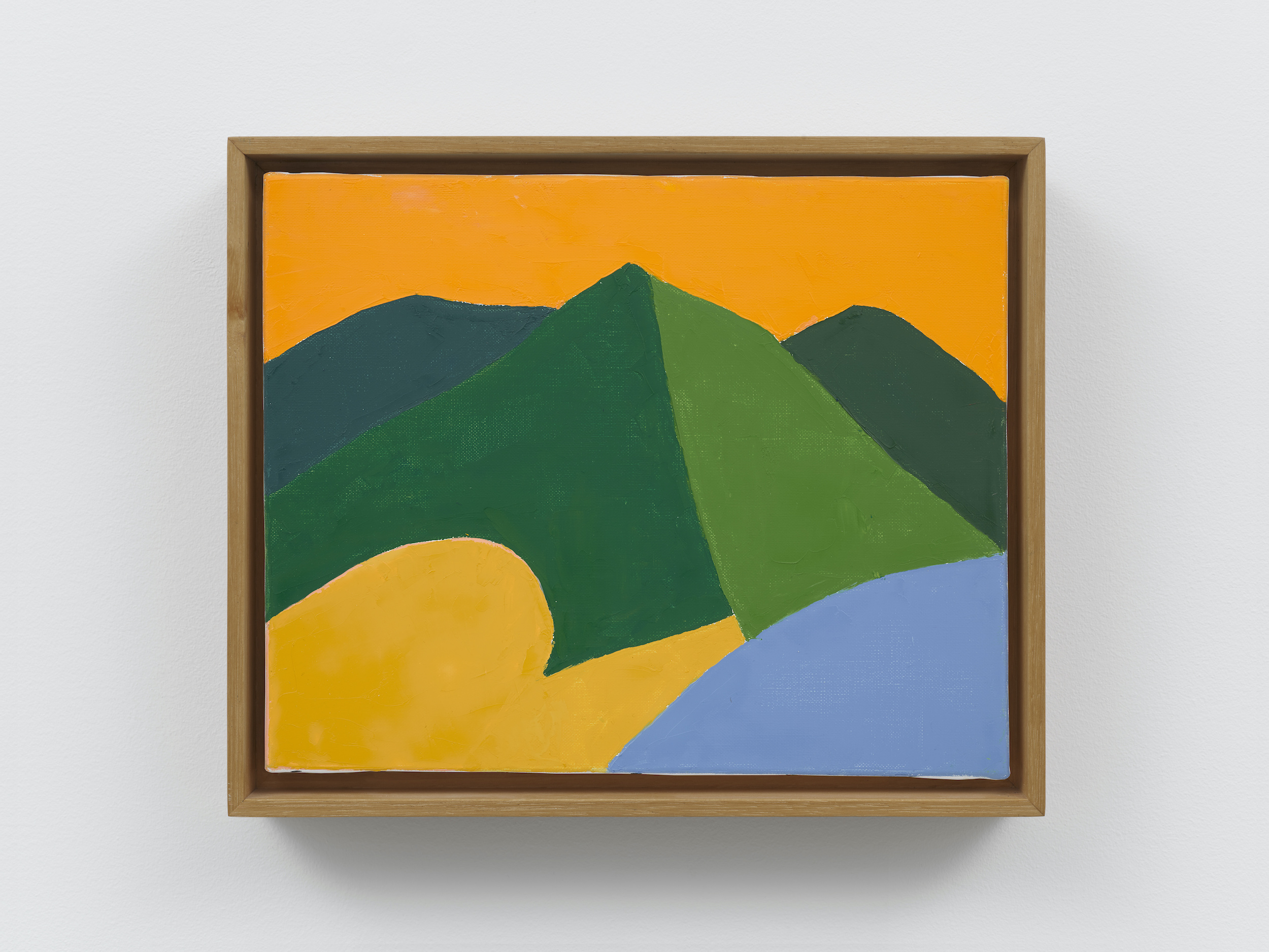“This unfinished business of my/childhood/this emerald lake/from my journey’s other/side/haunts hierarchies of heavens,” wrote the late artist Etel Adnan in her poem “The Spring Flowers Own” (1990). In her exhibition This Beautiful Light at White Cube, an emerald color field unfurls on a wall-sized grid of ceramic tiles. Among the uneven washes of green are blocks of primary colors and a multicolored shape thrusting diagonally across the picture plane, creating a sensation of whirring motion.
This work, “Apple Tree” (2021), is the clear centerpiece, but paintings and tapestries comprise the majority of the two-floor exhibition. The small paintings on view allude to both landscapes and geometric abstraction. Their swaths of color, applied with a palette knife, evoke eroding forms, or the dominance of nature’s will over humankind’s. In one untitled composition, parched greens and earth tones cohere into a mountainous landscape drenched in late afternoon light; in another, blocks of color suggest an interior with an oblique view of a window. In nearly all, the images seem to vibrate from the chromatic contrast.
The bright, saturated colors and gestural marks of Adnan’s tapestries diverge from the paintings’ muted hues and geological forms. Although some resemble landscapes, as in the tree-like “Figues” (2021) and “Oasis” (1960s), with its abstracted cacti and blazing pink sun against a red sky, most point to mark making as much as image making. The dye stains the thread to create an indelible mark similar to those in her leporellos, or accordion-folded books, two of which are fanned out in vitrines. In these pieces, Adnan’s writing and art practices flow into one another.
The texture and technique of the tapestries also summon associations that the paintings can’t. The weave references the kilims (flat-weave rugs) that are common in West Asian countries, and by extension the idea of home as both a real place and an unsettled abstraction for an artist who traversed multiple cultures.
Born in 1925 in Beirut to a Greek Christian mother and Syrian Muslim father, Adnan was multicultural from the start — she spoke Greek and Turkish at home and, like many others in Lebanon, which was under France’s rule until 1943, she learned French at school. As a young adult, she studied philosophy in Paris at the Sorbonne and in the United States at the University of California, Berkeley.

Communing with the paintings can be an intimate experience. Maybe for some it’s because of their small scale and meditative stillness; others may feel a personal connection with the imagery. How many visitors had been raised, like myself, in the diaspora, surrounded by pictures and stories of a bygone Lebanon, grown-ups mythologizing the landscape so that it seemed eternal to a child, the sun-bleached buildings and Roman ruins radiating an otherworldly light?
In late 2022, I visited an exhibition of Adnan’s art and writing at Lenbachhaus in Munich that incorporated a few German Expressionist pieces. The vocabulary of modernism is embedded in her work, not least because it spanned the different cultural spheres in which she lived and worked, and the influence of France overlaid the culture of her Lebanon. But too often the term modernism applied in a Euro-American context to a non-White artist comes with an orientalizing impulse. Lenbachhaus specializes in art by German Expressionists, and by the Blue Rider artists specifically, in the city that gave birth to that group, so a European atmosphere pervades the museum. Yet the projection of European modernism onto Adnan’s aesthetic, which renders her a perpetual outsider even in her own art, is not specific to the Munich show; it is presupposed whenever her work is situated in relation to Euro-American abstraction.

At the same time, an ambiguous sense of place is inscribed in her art. She grew up in a primarily Arabic-speaking society without speaking the language at home, she straddled cultural identities, and her art commingles the natural environments of Lebanon and California, two of her longtime homes (along with Paris). From this perspective, the quietude of her paintings is alive with both multiplicity and instability. The suns that appear repeatedly in her work may bear witness to the changes caused by humans, but even they take different forms; her book-length poem The Arab Apocalypse, published in 1989 and written during the Lebanese Civil War (1975–90), opens with myriad suns: “A yellow sun/A green sun/a yellow sun/A red sun/a blue sun.”
Several more hold court in this show. One modest work depicts a sliver of tan sky above a high horizon line; below, the canvas is divided into different shades of blue, pierced by a small, pale yellow orb. Though ensconced in the sea, this celestial body provides warmth and light to sustain life, a reflection of the warmth and light with which Adnan imbued her art. Her first poem, she explained in an interview published in the Paris Review, was “about the marriage of the sun and the sea.” Here, all appears serene, but it can be deceptive. Throughout The Arab Apocalypse, the sun travels and morphs; it doles out and takes abuses: “The sun has its mouth stitched with barbed wire.”
Then again, the poem ends, “in the night we shall find knowledge love and peace.”






Etel Adnan: This Beautiful Light continues at White Cube (1002 Madison Avenue, Upper East Side, Manhattan) through March 1. The exhibition was organized by the gallery.

